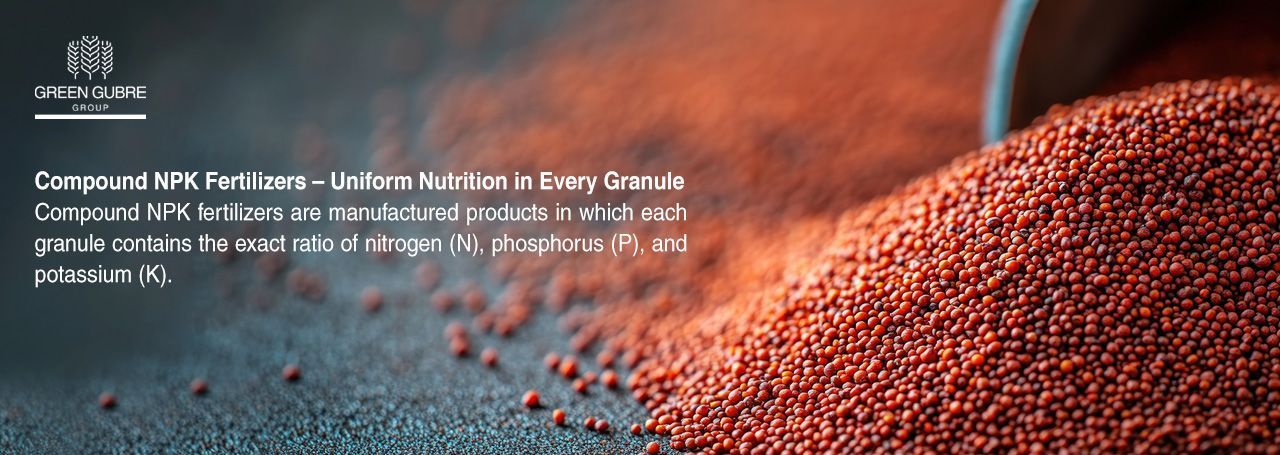Compound NPK Fertilizers – Uniform Nutrition in Every Granule
Compound NPK Fertilizers – Uniform Nutrition in Every Granule

Introduction: Engineered Consistency for Modern Farming
Compound NPK fertilizers are manufactured products in which each granule contains the exact ratio of nitrogen (N), phosphorus (P), and potassium (K). Unlike bulk blends, where individual nutrients are mixed and may segregate during handling, compound fertilizers ensure a consistent nutrient composition in every granule applied to the field. This uniformity improves crop nutrition efficiency, enhances nutrient balance in each application zone, and simplifies logistics for farmers.
With modern agriculture shifting toward precision application, compound NPK fertilizers have become essential on large-scale commercial farms, in export-oriented horticulture, and intensive cropping systems. Their engineered uniformity leads to better root zone coverage, minimized nutrient competition, and a reliable foundation for high yields.
1. What Makes Compound NPK Fertilizers Unique?
Compound NPK fertilizers are chemically or physically combined to ensure that each granule contains all three macronutrients. They are produced through industrial processes such as:
- Nitro-Phosphate Process (NP/NPK): Acidifies phosphate rock with nitric acid to produce a base for combination with potassium and ammonium.
- Ammonium Phosphate Slurry Granulation: Urea, ammonium phosphate, and potassium salts are granulated into homogeneous particles.
- Steam Granulation or Melting Technology: Ensures even nutrient fusion and granule hardening for consistent size and composition.
Key Benefits:
- Each granule delivers a complete nutrient supply—ideal for even field distribution.
- Minimizes segregation during storage, transportation, and spreading.
- Ensures balanced nutrient availability at every point along the crop root.
- Reduces the risk of over- or under-feeding in specific areas of the field.
This makes compound fertilizers especially useful in mechanized application systems, such as broadcast spreaders and air seeders.
2. Common Compound NPK Grades and Applications
Compound fertilizers are available in a range of nutrient ratios designed explicitly for various crops, soils, and farming systems. Some standard formulations include:
- 15-15-15: Balanced formula for general-purpose use in cereals, pastures, and vegetables.
- 16-16-16 + S + Zn: Widely used in maize and rice-growing areas for uniform nutrient supply.
- 12-24-12: High-phosphorus grade for basal application in legumes and oilseeds.
- 8-24-24: Focused on root and reproductive growth, often used in sugar beet and sunflower.
- 20-20-0 + Ca + B: Applied in horticulture for fruiting vegetables and citrus.
- 16-8-24 + MgO: Ideal for potassium-demanding crops like bananas, potatoes, and tobacco.
Custom compound grades can also be developed based on crop growth stage, local climatic conditions, and soil nutrient balance identified through testing.
3. Why Choose Compound Fertilizers? Agronomic and Operational Benefits
- Precision Feeding: Each plant receives an equal proportion of nutrients—reducing variability in crop performance and enhancing uniform growth.
- Ease of Application: Compound NPKs are compatible with all modern spreaders, reducing clogging and uneven application common with blends.
- Labor and Time Efficiency: No need to apply separate fertilizers for N, P, and K—saves time, machinery fuel, and application costs.
- Storage and Handling: Stable granules with uniform size and moisture resistance allow for extended storage and minimal nutrient loss.
- Nutrient Synergy: Co-delivery of nutrients improves nutrient-use efficiency (NUE). For example, phosphorus facilitates root uptake of both nitrogen and potassium when applied together.
4. Global Adoption and Market Trends
The compound NPK segment has seen rapid adoption in countries with commercialized agriculture and export-oriented horticulture:
- Europe: High-value crops like potatoes, vegetables, and grapes benefit from uniform granules and micronutrient-enriched grades.
- Brazil: Sugarcane, soy, and coffee growers use custom compound formulas with sulfur, magnesium, and boron for optimized performance.
- China & India: Governments encourage compound use through subsidies to improve nutrient balance and reduce over-application of single nutrients.
- Africa: In regions like Kenya, Ghana, and Tanzania, compound fertilizers are promoted through agro-dealer programs and crop-specific formulas (e.g., 23-10-5 + S + Zn for maize).
The global compound NPK fertilizer market is projected to exceed $120 billion by 2030, driven by mechanization, nutrient-use efficiency mandates, and growing demand for export-grade crops.
5. Green Gubre Group – Tailored Compound Solutions for Your Fields
At Green Gubre Group, we provide a broad portfolio of compound NPK fertilizers designed for different regions, crops, and nutrient requirements:
- High-efficiency compound grades in granular or coated form
- Micronutrient-enriched NPKs with added zinc, sulfur, magnesium, and boron
- Customized formulas developed in collaboration with agronomists and research institutes
- Logistics and technical support for large-scale farming and cooperative supply chains
- Bulk packaging and bagged solutions (50 kg, 1 MT, and custom print options)
Whether you manage a plantation, greenhouse, or smallholder cooperative, our compound fertilizers offer the simplicity, precision, and performance to meet your goals.




